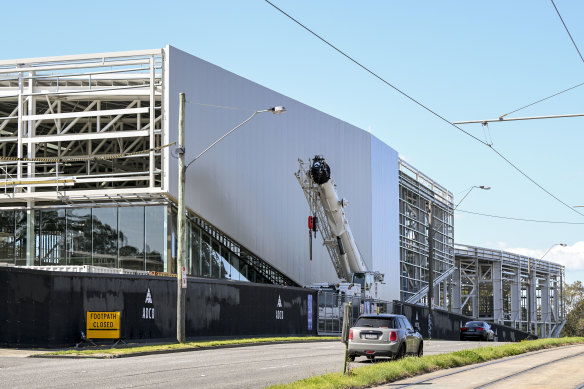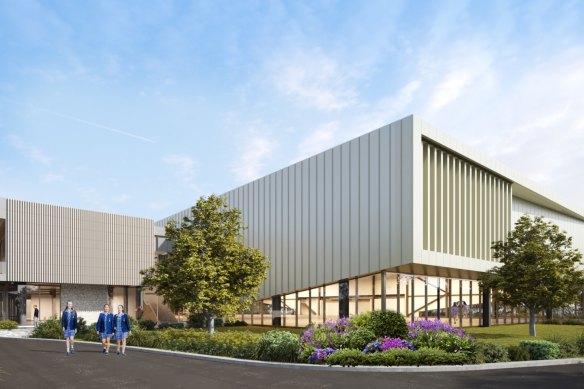- Exclusive
- National
- Victoria
- Private schools
This was published 7 months ago
Private school splashes $85 million on ‘humble’ new pool complex
By Noel Towell
A Melbourne private school’s new swimming and sports complex – once described by a local Labor MP as “humble” – is set to cost $85 million.
Presbyterian Ladies College (PLC) has not previously disclosed the cost of the 25-month build for the new sports and aquatic centre, but confirmed it on Wednesday.

The new sport and aquatic centre of the Presbyterian Ladies’ College this week.Credit: Eddie Jim
In June last year, the eastern suburbs school – where annual year-12 fees are $38,000 – sought an exemption from the state government’s new payroll tax regime for high-fee Catholic and private schools, via Box Hill MP Paul Hamer.
The school told The Age that the new centre – years in the planning – was a badly needed upgrade to its existing sports facilities, a pool built 33 years ago and a 60-year-old netball court.
PLC has consistently said that the new sports centre would be paid for by the school’s cash reserves, bank borrowing and donations and with no federal or state government funding.
When the new sporting complex on Burwood Rd opens, PLC students will be able to enjoy a 50 metre, eight-lane swimming pool, a learn-to-swim pool, diving towers and seating for 400 spectators.

Concept drawings of Presbyterian Ladies College new Sports Aquatic and Fitness Centre.Credit: ADCO Constructions
The facility can also be reconfigured for badminton, netball and volleyball and will feature a gymnasium, spin room, multipurpose spaces for aerobics, dance, relaxation, table-tennis and class teaching, staff areas, collaborative meeting spaces and an underground carpark.
The project cost comes to light as Hamer’s front bench colleague, Education Minister Ben Carroll, battles his federal counterpart Jason Clare over funding for the state’s cash-strapped public schools.
In 2022, PLC received $9.25 million in federal funding and $1.285 million from the state government – about $7160 in total government funding for each of the 1470 students enrolled in the Burwood academy that year.
The school’s financial mainstay – fees paid by parents – brought in another $43 million, and private donations brought the total funding per student to $38,000.
State and federal government funding per child in the state’s public schools that year was less than $16,000, with fees, charges and donations taking the total per student to about $16,800.
When Hamer appealed to Victorian Treasurer Tim Pallas last year for an exemption for PLC from the state’s controversial payroll tax, the Box Hill MP described the sporting centre development as “humble”.
“Their master planning aspirations have been humble and funded within their own means,” Hamer wrote to Pallas.
PLC – which traces its history back 148 years and counts former federal cabinet minister Kelly O’Dwyer, opera singer Dame Nellie Melba and former lord mayor of Melbourne Sally Capp among its alumni – was not granted a tax exemption.

Labor MP Paul Hamer’s plea for tax relief for Presbyterian Ladies College.
A school spokesperson said on Wednesday that the surrounding community, where quality sporting facilities were in short supply, would benefit from PLC’s new development, for which the school had been marshalling its finances for years.
“We are looking at ways to make the new centre available for community use in an area which has few similar facilities,” the spokesperson said.
“We are actively talking with community sports clubs – basketball, netball, and gymnastics – who want to use the facilities to run their programs after school hours.
“The school is also in discussion with local primary schools who are interested in running their swimming programs in the new aquatic facilities.”
Hamer did not comment on Wednesday.
A spokesperson for Carroll said that advocating for constituents and local institutions was part of an MP’s jobs.
“Local members of parliament are responsible for passing on the views of constituents and organisations in their electorates, and our MPs take this very seriously,” the minister’s spokesperson said.
“The fact is the Commonwealth Government continues to shortchange government school students in Victoria by $1000 per student.”
Independent Schools Victoria chief executive Rachel Holthouse said parents – not governments – paid for the facilities at independent schools.
“Capital works in independent schools are in almost every case funded by the school itself, drawing on its own resources,” Holthouse said.
“Only a small number of non-government schools which meet strict eligibility requirements can apply for limited government funding provided for capital works.”
Start the day with a summary of the day’s most important and interesting stories, analysis and insights. Sign up for our Morning Edition newsletter.